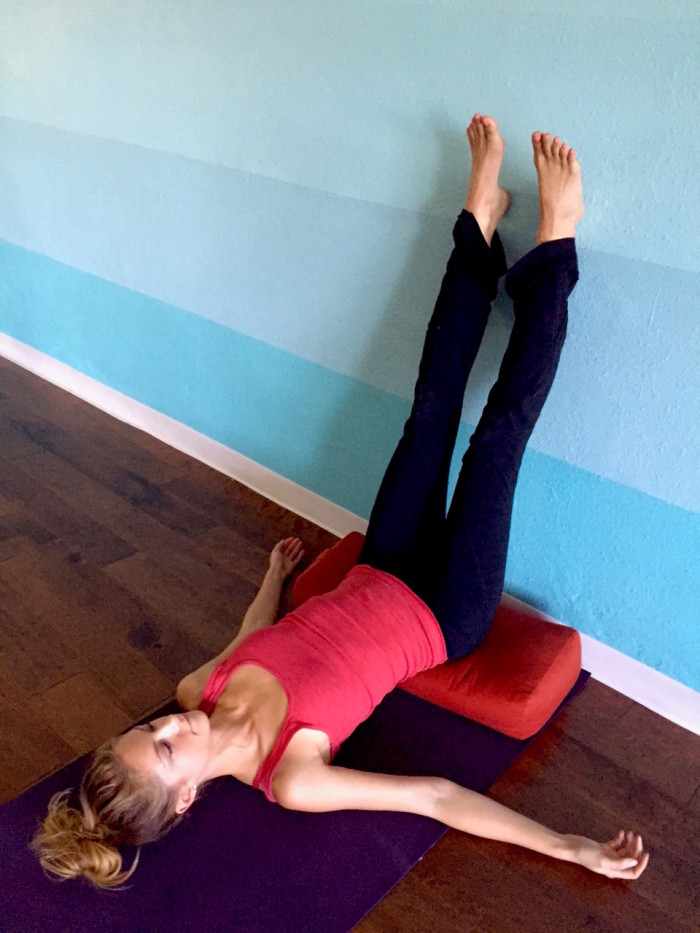To many beginner yogis, a yoga practice’s simpler poses may appear to be nothing more than a welcomed respite during a challenging class. After all, who doesn’t love Child’s Pose or Shavasana? But, upon developing one’s practice, it becomes unambiguous that this is not entirely the case. In Hatha yoga, Viparita Karani is often called “Legs Up the Wall Pose,” but viparita translates as “inverted,” and karani means “in action.” Moreover, many have interpreted Viparita Karani to mean the inversion of typical actions occurring in the body, such as sitting and standing. Therefore, practicing this pose allows one to reap the many benefits of shaking up humdrum, routine bodily actions. The best part about it: you don’t even have to be a yogi!

Do you sit at a desk all day? Are you like the average American who spends approximately an hour a day driving to work? Or, do you spend heaps of time staring at a computer or cell phone? If so, give legs up the wall pose a try. Follow these steps to ensure a safe, grounding pose that will instantly relieve you of stress and overwhelming feelings.
How to Practice Legs Up the Wall
–Before trying the pose, you will need support. If you are stiff, the support (a yoga blanket or pillow bolster should do) should be lower on your back and placed farther from the wall. If you are more flexible, use a higher support that is closer to the wall.
–Experiment with the position and distance of your support to find what works for you. In addition, some may choose to fall deeper into relaxation by using an eye mask. Begin with your support about six inches away from the wall. Sit sideways on one end of your support, with your side against the wall. Exhale to initiate a sweeping motion and swing your legs up to rest against the wall. Separate your legs to a width that feels comfortable. Rest your head and shoulders gently on the floor.
–Now, your torso should be gently arched from the pubis to the top of the shoulders. Soften your body. You may place a small towel under your neck for extra support (if your spine feels flat!) Release your hands and arms out to your sides, palms up. Or, if it is more natural, bend your arms and place them on your sides—like a football goal post.

–Maintain your vertical leg position and breathe into the pose. Remain this way for 5 to 15 minutes. Do be careful coming out of the pose—do not twist! Rather, slide off the support to ground your pelvis on the floor. Then, turn to one side and take a few breaths. Exhale to return back to sitting.
While many yoga experts espouse practicing this pose for 10 to 15 minutes, you can still feel the benefit while sitting there for just a minute or two. Legs up the wall can foster a meditative state and reset the nervous system. Intended as a deeply relaxing pose, partnering this posture with slow, deep breathing will trigger your “rest and digest” nervous response. But, there is more to it than a gentle relaxation! This pose boasts physiological benefits as well: it can relieve edema, alleviate headaches, and soothe menstrual cramping. Even the Hatha Yoga Pradipika claims that after six months of this practice, gray hair and wrinkles become inconspicuous. Though the jury is still out on that one, it is undeniable that this simple pose holds immense promise.
What are you waiting for? Use gravity to your advantage and gain a new perspective!
Also by Leigh: How to Practice Ujjayi Breath for a Healthy Response to Stress
How to Create Your Own Aromatherapy Mood Blends
Related: Restorative Yoga for Summer: 30-Minute Cooling Sequence
Get more like this–sign up for our newsletter for exclusive inspirational content!
__
Photos: Hivemind via Flickr, Annika Ihnat




